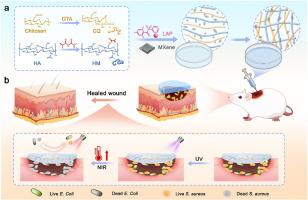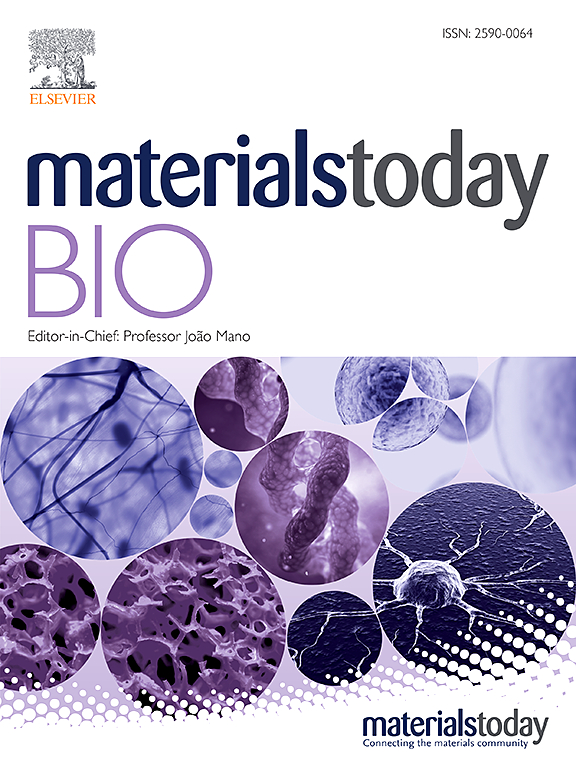基于季铵盐接枝壳聚糖和透明质酸的光交联注射型光热抗菌水凝胶,用于感染伤口愈合
IF 10.2
1区 医学
Q1 ENGINEERING, BIOMEDICAL
引用次数: 0
摘要
抗菌水凝胶不仅能为皮肤伤口提供更好的环境以避免感染,还能加速伤口愈合。本文设计并合成了经季铵盐修饰的壳聚糖(CQ)和与甲基丙烯酸酯接枝的透明质酸(HM),制备了一种可注射的光交联水凝胶,用于伤口敷料,具有固有的抗菌和光热特性。CQ 和 HM 表现出优异的生物相容性、更高的保水性和抗菌活性,显示出作为抗菌材料在各种应用中的巨大潜力。MXene 是一种二维纳米材料,因其光热特性而受到广泛研究。CQ 和 HM 聚合物前体可与 Mxene 混合,然后在温和条件下用 395 纳米紫外线辐射交联,形成三维网络结构的 CQ-HM/MXene 水凝胶。这种水凝胶具有适当的溶胀率、弹性模量、光热性能和良好的生物相容性。水凝胶的可注射特性使其能够轻松覆盖伤口。体外和体内研究表明,这种可注射水凝胶具有较低的细胞毒性和出色的抗菌性能,有助于促进伤口愈合。总之,这种新型 CQ-HA/MXene 水凝胶因其固有的抗菌活性和光热效应,具有应用于皮肤伤口愈合的潜力。本文章由计算机程序翻译,如有差异,请以英文原文为准。

Photo-crosslinking injectable Photothermal antibacterial hydrogel based on quaternary ammonium grafted chitosan and hyaluronic acid for infected wound healing
Antibacterial hydrogels not only provide a better environment for skin wounds to avoid infection but also accelerate wound healing. Herein, chitosan modified by a quaternary ammonium salt (CQ), and hyaluronic acid grafted with methacrylate (HM) were designed and synthesized to prepare an injectable photo-crosslinking hydrogel for wound dressing with inherent antibacterial and photothermal properties. CQ and HM exhibited excellent biocompatibility, improved water retention, and antibacterial activity, illustrating vast potential as an antibacterial material in various applications. MXene, a type of 2D nanomaterial, has been widely researched due to its photothermal properties. The CQ and HM polymer precursor could be mixed with Mxene and then crosslinked with 395 nm UV radiation under mild conditions to form a 3D network structure CQ-HM/MXene hydrogel. This hydrogel displayed an appropriate swelling ratio, elastic modulus, photothermal property and excellent biocompatibility. The injectable property of the hydrogel allowed it to easily cover the wound. In vitro and in vivo studies showed that the injectable hydrogel had low cytotoxicity and excellent antibacterial properties, which could help promote wound healing. In summary, this novel CQ-HA/MXene hydrogel has the potential for application in skin wound healing due to inherent antibacterial activity and photothermal effect.
求助全文
通过发布文献求助,成功后即可免费获取论文全文。
去求助
来源期刊

Materials Today Bio
Multiple-
CiteScore
8.30
自引率
4.90%
发文量
303
审稿时长
30 days
期刊介绍:
Materials Today Bio is a multidisciplinary journal that specializes in the intersection between biology and materials science, chemistry, physics, engineering, and medicine. It covers various aspects such as the design and assembly of new structures, their interaction with biological systems, functionalization, bioimaging, therapies, and diagnostics in healthcare. The journal aims to showcase the most significant advancements and discoveries in this field. As part of the Materials Today family, Materials Today Bio provides rigorous peer review, quick decision-making, and high visibility for authors. It is indexed in Scopus, PubMed Central, Emerging Sources, Citation Index (ESCI), and Directory of Open Access Journals (DOAJ).
 求助内容:
求助内容: 应助结果提醒方式:
应助结果提醒方式:


